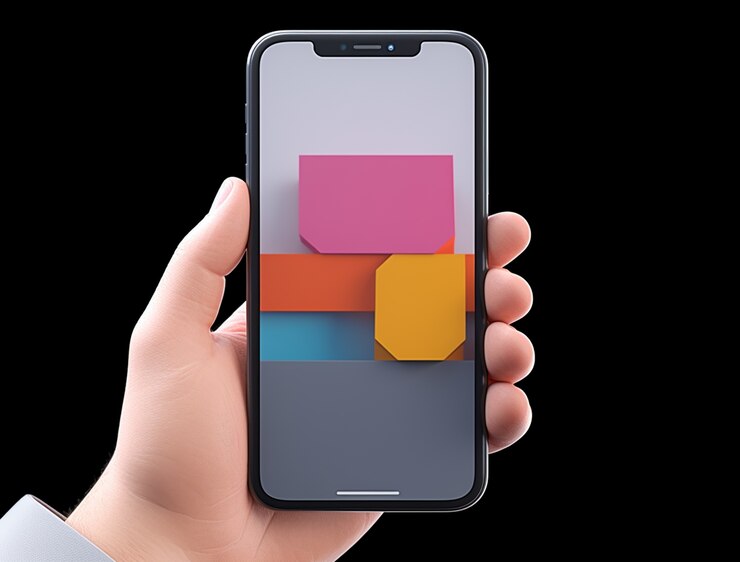Why Mobile-First Design Matters to Boost Engagement & Conversions

Did you know that as of 2023, over 60% of all web traffic comes from mobile devices? It’s true! This staggering statistic highlights a fundamental shift in how we access online content. With more people relying on their smartphones and tablets to browse the web, businesses can no longer afford to treat mobile optimization as an afterthought. If your website isn’t designed with mobile users in mind, you’re potentially missing out on a significant portion of your audience.
Enter Mobile-First Design, a crucial strategy in today’s digital landscape. Unlike traditional web design, which often prioritises desktop layouts and then adapts them for smaller screens, Mobile-First Design starts with the mobile user experience at its core. This approach ensures that your website is not only responsive but also offers an optimal user experience on the devices that matter most. For businesses struggling to achieve their desired results with their current websites, Mobile-First Design can be a game-changer.
In this blog, we’re going to dive into Mobile-First Design using the Golden Circle framework, which breaks down the approach into three essential questions: Why, How, and What. We’ll explore why Mobile-First Design is critical for your business, how you can effectively implement it, and what it entails in practical terms. By the end of this article, you’ll understand how prioritising mobile can transform your website’s performance and help you connect more effectively with your target audience. Let’s get started!
II. Why Mobile-First Design?
Mobile-First Design is a game-changer for businesses in today’s digital world, where mobile usage has surpassed desktop. By prioritising mobile users, you can boost engagement, improve your SEO rankings, and stay ahead of the competition. Ignoring this approach can lead to high bounce rates, poor user engagement, and lost revenue opportunities.
Understanding User Behaviour
Let’s be real – we live in an age where most people access websites through their mobile devices. Mobile internet usage has actually surpassed desktop! So, it’s crucial for businesses to cater to this growing mobile audience. Mobile devices have become the go-to for information, services, and online shopping. If your website isn’t optimised for mobile, you risk alienating a large chunk of your potential customers. By adopting a mobile-first approach, you ensure your website is designed with these users in mind, providing a seamless and enjoyable experience that keeps them coming back.
- Why it matters: Engaging the growing number of mobile users is essential to stay relevant and accessible.
- What happens if you don’t: Higher bounce rates, lower user engagement, and losing customers who find your site difficult to navigate on mobile devices.
Business Imperatives
Switching to a Mobile-First Design isn’t just about keeping up with trends; it’s a strategic move that can significantly impact your bottom line. Websites with a superior mobile experience tend to see higher engagement rates, increased customer retention, and ultimately, better conversion rates. In today’s competitive market, having a mobile-optimised website can set you apart from businesses that still prioritise desktop design. By focusing on mobile-first, you’re making sure your site is ready for the future and the continuing rise in mobile usage.
- Why it matters: To achieve higher engagement, retention, and conversion rates, giving you a competitive edge.
- What happens if you don’t: Missed opportunities for higher engagement, lower conversion rates, and falling behind competitors with better mobile experiences.
SEO and Performance Benefits
One of the best reasons to adopt Mobile-First Design is the SEO boost it offers. Google has moved to mobile-first indexing, meaning it primarily uses the mobile version of your content for indexing and ranking. A mobile-optimised site can improve your search engine rankings, making it easier for potential customers to find you. Additionally, mobile-first sites usually have better performance metrics, like faster load times, which are crucial for keeping users satisfied and engaged. A faster, more responsive site not only keeps users happy but also reduces bounce rates, leading to more successful interactions and transactions.
- Why it matters: To improve search engine rankings and make your site more discoverable.
- What happens if you don’t: Lower search engine rankings, decreased organic traffic, higher bounce rates, and potential loss of revenue from users who abandon slow-loading sites.
Relevance to Target Audience
For businesses with websites that aren’t delivering the results they expect, adopting Mobile-First Design can be a game-changer. Many sites struggle with high bounce rates and low engagement simply because they aren’t optimised for the devices most users prefer. By redesigning your website with mobile users as the primary focus, you can address these issues head-on. This approach ensures that your content is accessible, your navigation is intuitive, and the overall user experience is enhanced. Embracing Mobile-First Design can turn an underperforming website into a powerful tool for growth and engagement.
- Why it matters: To transform underperforming websites and improve user engagement.
- What happens if you don’t: Continued poor website performance, high bounce rates, low user engagement, and missed opportunities for growth and customer satisfaction.
III. How to Implement Mobile-First Design?
Optimise your website for mobile with Mobile-First Design. Start with the smallest screen and scale up to ensure optimal performance for mobile users. Learn essential steps, from shifting your mindset to practical tips, to adopt a mobile-first approach effectively.
Mindset Shift
First things first, you need to change your mindset. Traditional web design often starts with desktop experiences and adapts them for mobile later. But with Mobile-First Design, you start with the smallest screen and work your way up. This ensures the most critical elements are prioritised, making the user experience seamless across all devices.
- Step: Start thinking mobile-first by beginning the design process with mobile devices in mind.
- Outcome: A focused, streamlined design that makes essential content and features accessible on mobile devices.
Design Principles
When designing for mobile, simplicity and minimalism are key. With limited screen space, every element must have a purpose. Touch-friendly interfaces are a must since mobile users navigate with their fingers. Think larger buttons, intuitive gestures, and clear navigation to enhance usability.
- Step: Focus on simplicity, minimalism, and touch-friendly design principles.
- Outcome: A clean, user-friendly design that improves mobile usability and user satisfaction.
Technical Considerations
Responsive design is at the heart of Mobile-First Design. This means using fluid grids and flexible images to ensure your site adapts smoothly to different screen sizes. Performance optimization is just as important since mobile users expect fast load times. Efficient coding practices, like minimising JavaScript and CSS, can make a big difference.
- Step: Use responsive design techniques and optimise performance.
- Outcome: A website that adapts to different screen sizes and loads quickly, enhancing the user experience.
User-Centred Approach
Understanding your mobile users’ needs and behaviours is crucial. Conduct user research and testing to gather insights into how your audience interacts with your site on mobile devices. This iterative design process involves continuous feedback and improvement, ensuring the final product meets user expectations.
- Step: Conduct user research and testing to understand mobile user needs and behaviours.
- Outcome: An optimised design that aligns with user expectations and provides a superior mobile experience.
Practical Steps for Our Target Audience
For businesses with underperforming websites, transitioning to Mobile-First Design can tackle specific pain points. Start by identifying areas where your current site falls short for mobile users. Use tools and resources like mobile-first frameworks and design software to help with the transition. Make changes gradually, testing each step to ensure improvements.
- Step: Identify pain points, use mobile-first tools, and implement changes gradually.
- Outcome: A transformed website that meets mobile user needs and boosts engagement and performance.
By following these steps, you can successfully implement Mobile-First Design and ensure your website is optimised for the devices most users prefer. This approach not only enhances the user experience but also drives engagement, retention, and conversions.
IV. What is Mobile-First Design?
Mobile-First Design prioritises the mobile user experience by starting with the smallest screen and scaling up. Unlike traditional web design, this approach ensures critical elements are optimised for mobile devices, creating a streamlined and efficient user experience across all devices. Focus on layout, content prioritisation, and functionality to meet the needs of today’s mobile-centric users.
Key Elements
Several key elements define Mobile-First Design, each contributing to a top-notch mobile user experience:
- Prioritising Content: Make sure the most critical content is easily accessible on mobile devices. This often means simplifying the interface and focusing on the essentials.
- Adaptive Layouts: Design layouts that seamlessly adapt to various screen sizes using responsive design techniques like fluid grids and flexible images.
- Touch-Friendly Interfaces: Create interfaces that are easy to navigate using touch. Think larger buttons, intuitive gestures, and simplified navigation for finger taps and swipes.
- Performance Optimization: Ensure fast load times and smooth interactions on mobile devices by optimising images, reducing code bloat, and leveraging mobile-specific performance enhancements.
- Accessibility: Make designs inclusive and accessible to all users, including those with disabilities. This means following best practices for mobile accessibility, such as providing alternative text for images and ensuring proper contrast ratios.
Direct Benefits for Target Audience
If your website isn’t performing as well as you’d like, adopting Mobile-First Design can make a big difference. Here’s how:
- Improved User Engagement: A mobile-optimised site keeps users engaged by offering a seamless and enjoyable browsing experience, leading to lower bounce rates and higher retention.
- Higher Conversion Rates: Simplified navigation and prioritised content make it easier for users to find what they need and take action, resulting in increased conversions.
- Better SEO Performance: Mobile-First Design aligns with Google’s mobile-first indexing, improving your search engine rankings and driving more organic traffic to your site.
- Enhanced Brand Perception: A website that works well on mobile devices reflects positively on your brand, showing your commitment to user experience and modern design standards.
By understanding and implementing Mobile-First Design principles, businesses can ensure their websites meet the expectations of today’s mobile-savvy users. This approach not only addresses the challenges of underperforming websites but also sets the stage for sustained growth and engagement in our increasingly mobile-centric world.
Switching to Mobile-First Design is a must in today’s mobile-centric world. By starting with the smallest screens and scaling up, you ensure your website delivers a seamless, efficient, and engaging experience for all users. This approach boosts user engagement, improves conversion rates, enhances SEO performance, and positively impacts your brand perception. For businesses with underperforming websites, Mobile-First Design can be a game-changer, paving the way for growth and customer satisfaction.
Ready to give your website a mobile-friendly makeover? At AhmedSohail.com, we specialise in Mobile-First Design and can help you optimise your site for the best possible mobile user experience. Visit AhmedSohail.com to learn more about our services and see how we can help your business thrive in the digital age.
—————————————————————————
References:
- Did you know that as of 2023, over 60% of all web traffic comes from mobile devices? – Statista
- Google has moved to mobile-first indexing, meaning it primarily uses the mobile version of your content for indexing and ranking. Google’s Mobile-First Indexing
Speak Your Mind

Do You Want More Sale?
I’m Ahmed Sohail, and I’m helping businesses grow with determined results. My question is, does your business needs online growth?

Comments (0)